WordPress sitenizi yeni bir alan adına taşımak, dikkatli bir planlama gerektiren büyük bir adımdır. Alan adınızı değiştirmek SEO sıralamanızı etkileyebilir, bu nedenle süreci dikkatli bir şekilde ele almak çok önemlidir.
Alan adı değişikliği sürecini birçok kez başarıyla yönettik, bu nedenle potansiyel tuzakları ve bunlardan nasıl kaçınılacağını ilk elden biliyoruz.
Alan adı geçişi sırasında geçici SEO dalgalanmaları kaçınılmaz olsa da bu etkiyi azaltabilirsiniz. Doğru yaklaşımla, arama trafiğinizi ve sıralamalarınızı hızla geri kazanabilirsiniz.
Bu kılavuzda, WordPress’i SEO’yu kaybetmeden yeni bir alan adına taşımanın doğru yolunu göstereceğiz.
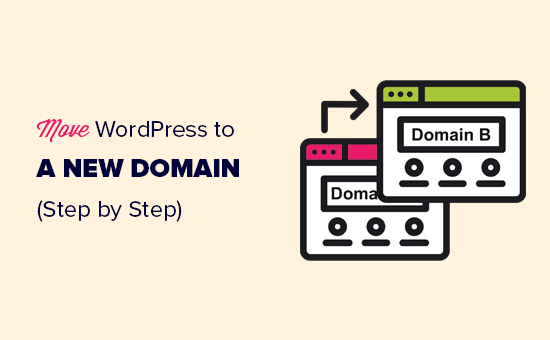
WordPress sitenizi yeni bir alan adına taşımak korkutucu olabilir, ancak öyle olmak zorunda değil. Sürecin her adımında size yol göstermek için buradayız.
WordPress sitenizi yeni bir alan adına taşımanın belirli bir adımına gitmek için aşağıdaki bağlantılardan herhangi birine tıklayabilirsiniz:
- What to Know Before You Change Domains
- Pre-Steps: What You Need to Get Started
- Step 1: Create a Duplicator Package of Your WordPress Site
- Step 2: Create a Database for Your New Domain Name
- Step 3: Unpack WordPress on Your New Domain Name
- Step 4: Set Up Permanent 301 Redirects
- Step 5: Notify Google About Your New Domain
- Notify Your Users About the New Domain Name
- Video Tutorial
Alan Adlarını Değiştirmeden Önce Bilmeniz Gerekenler
Başlamadan önce bilmeniz gereken birkaç şey var.
Yeni bir alan adına aktarma işlemi, Google ve diğer arama motorlarının değişikliklere uyum sağlaması gerekeceğinden arama motoru sıralamalarınızı geçici olarak etkileyecektir.
Ayrıca arama trafiğinizi de geçici olarak etkileyecektir. Lütfen bunun normal olduğunu ve yeni bir alan adına geçen tüm web sitelerinin başına geldiğini unutmayın.
Ancak bu kılavuzu takip ederek SEO etkisini önemli ölçüde azaltabilirsiniz. WordPress sitenizi yeni bir alan adına taşımanın, uygun 301 yönlendirmelerini ayarlamanın ve arama motorlarını bilgilendirmenin doğru yolunu göstereceğiz.
Lütfen bu kılavuzun bir WordPress sitesini yeni bir ana bilgisayara taşımak için olmadığını unutmayın. Bu yalnızca bir alan adını değiştirmek içindir. Süreç benzer olsa da, birkaç ekstra adım vardır. Bu ekstra adımlar SEO sıralamanızı ve trafiğinizi korumanıza yardımcı olacaktır.
Son olarak, eski web siteniz WordPress.com’daysa, bunun yerine WordPress. com’dan WordPress.org’a nasıl taşınacağına ilişkin kılavuzumuzdaki talimatları izlemeniz gerekir.
Ön Adımlar: Başlamak için İhtiyacınız Olanlar
Bu kılavuzda, WordPress web sitenizin oldsite.com’da kurulu olduğunu ve onu newsite.com’a taşımaya çalıştığınızı varsayıyoruz.
Ayrıca halihazırda bir WordPress hosting hesabınız olduğunu ve web hosting kontrol panelinize aşina olduğunuzu varsayıyoruz.
Ayrıca FileZilla gibi bir FTP istemcisini nasıl kullanacağınızı veya hosting hesabı kontrol panelinizde bulunan Dosya Yöneticisi uygulamasını kullanarak dosyaları nasıl düzenleyeceğinizi bilmeniz gerekir.
Bir web barındırma sağlayıcınız yoksa veya yeni bir sağlayıcıya geçmek istiyorsanız, Bluehost (küçük siteler için harika + ücretsiz alan adı ile birlikte gelir) ve SiteGround veya WP Engine (daha büyük siteler veya çevrimiçi mağazalar için harika) kullanmanızı öneririz.
Bunları yerine getirdiğinizde, süreci başlatmaya hazırsınız demektir!
Adım 1: WordPress Sitenizin Çoğaltıcı Paketini Oluşturun
Yapmanız gereken ilk şey WordPress sitenizin tam bir yedeğini oluşturmaktır.
Daha sonra bu yedeği web sitenizin bir kopyasını oluşturmak için kullanacaksınız, böylece eski alan adınızdan yenisine yönlendirmeleri düzgün bir şekilde ayarlayabilirsiniz.
Birçok WordPress yedekleme eklentisi mevcut olsa da, bu eğitim için Duplicator kullanacağız.
Duplicator en iyi WordPress yedekleme ve taşıma eklentisidir. Hem kendi işletmelerimiz hem de müşterilerimiz için sayısız web sitesini taşımak için kullandık. Çok büyük web siteleri için bile güvenilir bir şekilde çalıştığını gördük.
Not: Duplicator’ın bu geçiş için kullanabileceğiniz ücretsiz bir sürümü de mevcuttur. Ancak, otomatik bulut yedeklemeleri, tek tıklamayla web sitesi kurtarma, daha kolay geçişler ve daha fazlası gibi daha fazla özelliğin kilidini açmak için ücretli bir plana yükseltmenizi öneririz.
Eski alan adınıza Duplicator eklentisini yükleyip etkinleştirerek başlayalım. Daha fazla ayrıntı için, bir WordPress eklentisinin nasıl kurulacağına ilişkin adım adım kılavuzumuza bakın.
Eklenti etkinleştirildiğinde, WordPress yöneticinize bir Duplicator menü öğesi ekleyecektir. WordPress sitenizin yeni bir yedeğini veya kopyasını oluşturmak için Duplicator ” Yedekler sayfasına gitmeniz ve ardından ‘Yeni Oluştur’ düğmesine tıklamanız gerekir.
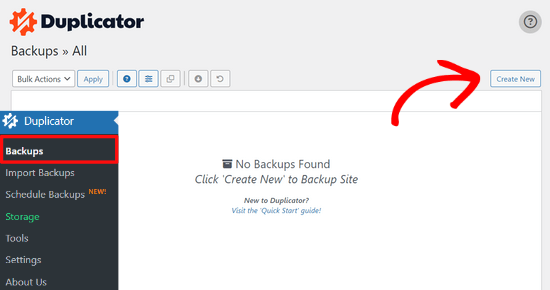
Duplicator şimdi arka sihirbazı başlatacak ve bu pakete otomatik olarak bir isim atayacaktır.
Devam etmek için ‘İleri’ düğmesine tıklayın.

Duplicator şimdi her şeyin yolunda olup olmadığını görmek için bazı testler yapacaktır. Eklenti bir sorun bulursa, talimatlar içeren bir uyarı göreceksiniz.
Tüm öğeler ‘İyi’ olarak işaretlenmişse, ‘Oluştur’ düğmesine tıklayın.

Eklenti şimdi web sitenizin dosyalarından bir çoğaltıcı paketi oluşturmaya başlayacaktır. Sitenizin büyüklüğüne bağlı olarak bu işlem birkaç dakika sürebilir.
Bitirdiğinizde, bir ‘İndir’ seçeneği göreceksiniz. Bu seçeneğe tıkladığınızda her iki dosyayı da indirme veya Yükleyici ve Arşivi (zip) ayrı ayrı indirme seçenekleri gösterilecektir.
Bilgisayarınıza indirmek için ‘Her İki Dosyayı da İndir’ seçeneğini seçin.

Arşiv dosyası, WordPress dosyalarınızın eksiksiz bir kopyasıdır. WordPress temalarınızı, kalıcı bağlantı ayarlarınızı, eklentilerinizi, yüklemelerinizi ve WordPress eklentileri tarafından oluşturulan diğer tüm dosyaları içerir.
Yükleyici betiği, arşiv dosyasını açarak WordPress geçişini otomatikleştirecek ve çalıştıracak bir PHP dosyasıdır.
Adım 2: Yeni Alan Adınız İçin Bir Veritabanı Oluşturun
WordPress sitenizi yeni alan adına taşımadan önce, WordPress’i yeni alan adınızda açmak için yeni bir SQL veritabanına ihtiyacınız olacaktır.
Zaten bir veritabanı oluşturduysanız, bu adımı atlayabilirsiniz.
Bir veritabanı oluşturmak için hosting hesabınızın cPanel kontrol panelini ziyaret etmeniz, ‘Veritabanları’ bölümüne gitmeniz ve ardından‘MySQL Veritabanları’ simgesine tıklamanız gerekir.
Bluehost’ta nasıl bulacağınızı göstereceğiz, ancak temel talimatlar aynıdır ve tüm barındırma sağlayıcıları için geçerli olmalıdır.
Bluehost hesap panonuza giriş yapın ve web sitenizin altındaki ‘Ayarlar’ düğmesine tıklayın.
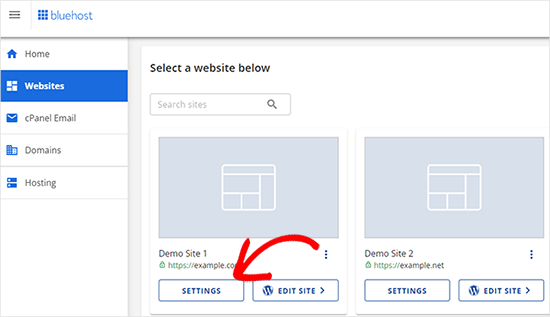
Site ayarlarınızın altında, ‘Gelişmiş’ sekmesine geçmeniz gerekir.
cPanel bölümüne doğru biraz aşağı kaydırın ve ‘Yönet’e tıklayın.
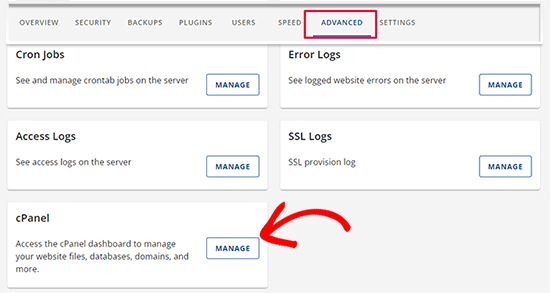
Bu işlem cPanel kontrol panelini açacaktır.
Veritabanları bölümüne ilerleyin ve ‘MySQL Veritabanları’ seçeneğine tıklayın.
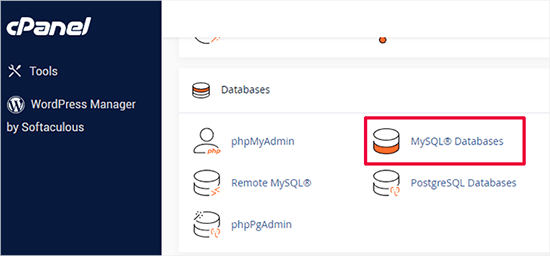
Not: Hosting kontrol paneliniz ekran görüntülerinden biraz farklı görünebilir. Ancak, yine de yeni bir veritabanı oluşturma seçeneği içeren bir Veritabanları bölümü bulabilmeniz gerekir.
Veritabanınız için bir ad girin ve ardından ‘Veritabanı Oluştur’ düğmesine tıklayın.
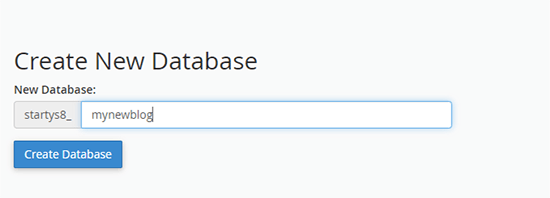
cPanel şimdi sizin için yeni bir veritabanı oluşturacaktır. Bundan sonra, MySQL Kullanıcıları bölümüne gitmeniz gerekiyor.
Ardından, yeni kullanıcınız için bir kullanıcı adı ve parola girin ve ‘Kullanıcı Oluştur’ düğmesine tıklayın. Kullanıcı adı ve şifreyi güvenli bir yere not ettiğinizden emin olun.
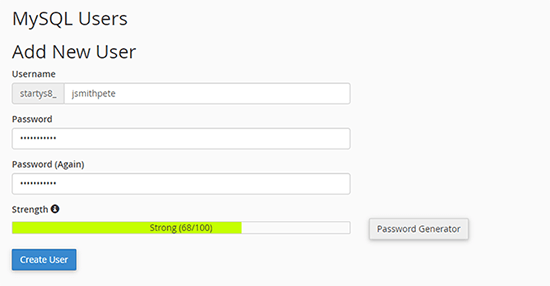
Yeni oluşturduğunuz kullanıcı hala veritabanı üzerinde çalışma iznine sahip değil. Bunu değiştirelim.
‘Veritabanına Kullanıcı Ekle’ bölümüne ilerleyin. İlk olarak, ‘Kullanıcı’ alanının yanındaki açılır menüden oluşturduğunuz veritabanı kullanıcısını seçin. Ardından yeni oluşturduğunuz veritabanını seçin ve ‘Ekle’ düğmesine tıklayın.
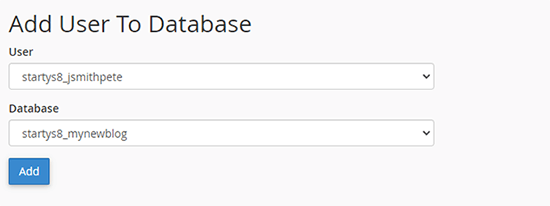
Ardından, kullanıcı için ayrıcalıklar seçmeniz istenecektir.
‘Tüm Ayrıcalıklar’ı seçin ve devam etmek için ‘Değişiklikleri Yap’ düğmesine tıklayın.
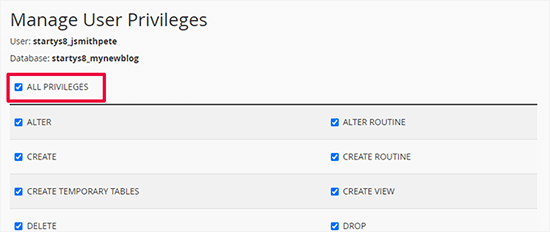
Veritabanınız artık hazırdır ve WordPress’i yeni alan adına taşımak için kullanılabilir.
Veritabanı adını, kullanıcı adını ve parolayı not ettiğinizden emin olun. Bu bilgilere bir sonraki adımda ihtiyacınız olacak.
3. Adım: WordPress’i Yeni Alan Adınızda Kullanıma Açın
Şimdi, daha önce indirdiğiniz Duplicator dosyalarını yeni alan adınıza yüklemeniz gerekir.
Duplicator paketi WordPress kurulumunuzu da içerir. Bu, yeni alan adınıza WordPress yüklemenize gerek olmadığı anlamına gelir.
İlk olarak, bir FTP istemcisi kullanarak alan adınıza bağlanın. Bağlandıktan sonra, web sitenizin kök dizininin tamamen boş olduğundan emin olun.
Bundan sonra, arşivi ve yükleyici dosyalarını kök dizine yükleyebilirsiniz. Bu genellikle public_html olarak adlandırılır.
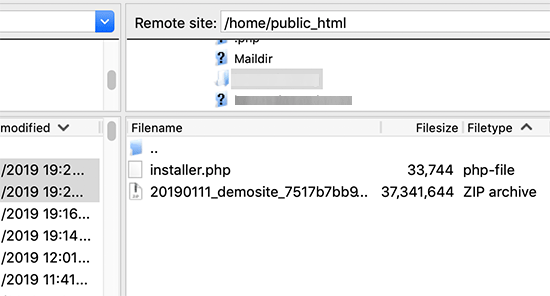
Her iki dosyanın da yüklenmesi tamamlandığında, artık WordPress’in paketini açmaya hazırsınız demektir.
Yeni bir tarayıcı sekmesi açın ve aşağıdaki URL’ye gidin:
http://example.com/installer.php
example.com adresini yeni alan adınızla değiştirmeyi unutmayın. Bu, Duplicator geçiş sihirbazını başlatacaktır.
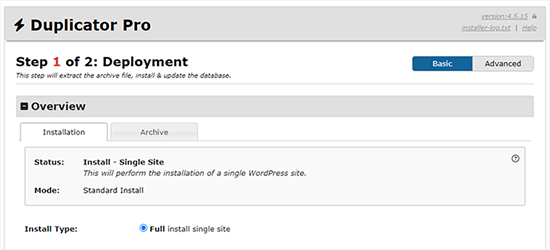
Yükleyici arşiv dosyasını arayacak ve ardından ekranda sizin için seçenekleri otomatik olarak seçecektir.
Bir önceki adımda oluşturduğunuz veritabanının bilgilerini girmek için biraz aşağı kaydırın.
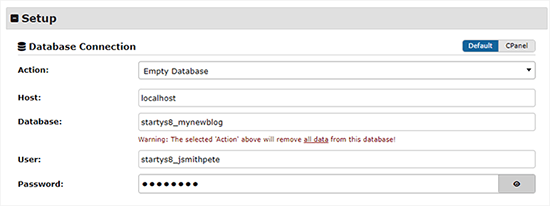
Bunun altında, Duplicator size otomatik olarak eski alan adınızın ve yeni alan adınızın URL’sini gösterecektir.
Her şey iyi görünüyorsa, devam etmek için ‘Doğrula’ düğmesine tıklayın.
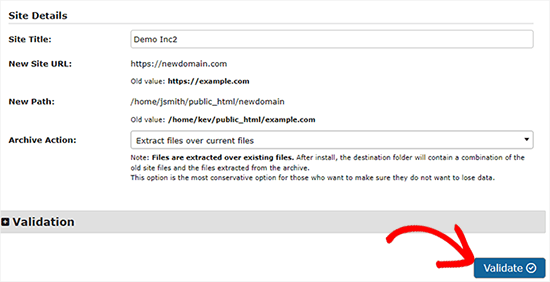
Duplicator şimdi verdiğiniz bilgileri kullanarak veritabanına bağlanmaya çalışacaktır.
Başarılı olduğunda, size bir Doğrulama Geçidi gösterecektir. Aksi takdirde, nasıl düzelteceğinize dair ayrıntılar içeren bir uyarı gösterecektir.
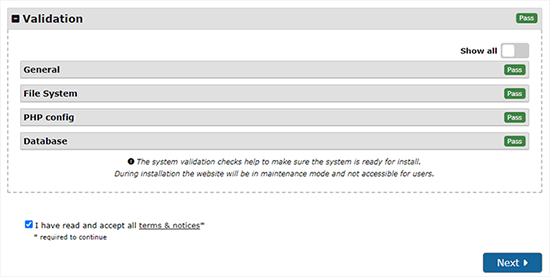
Devam etmek için ‘İleri’ düğmesine tıklayın.
Duplicator şimdi WordPress web sitenizi içe aktarmaya başlayacaktır. Bittiğinde, Yönetici Girişi düğmesiyle birlikte bir başarı mesajı göreceksiniz.
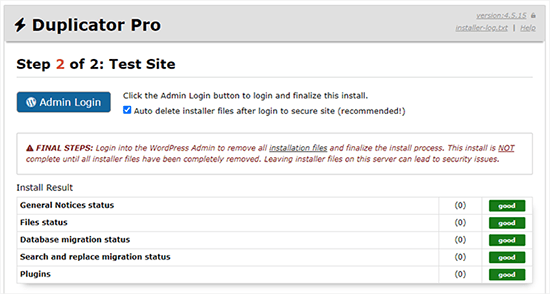
Duplicator URL’leri otomatik olarak yeni alan adınıza güncelleyecektir. Şimdi sonraki adımları tamamlamak için ‘Yönetici Girişi’ düğmesine tıklayabilirsiniz.
Adım 4: Kalıcı 301 Yönlendirmelerini Ayarlayın
Bir sonraki adım, eski alan adınıza gelen kullanıcıları yeni alan adına yönlendirmektir. Bu, 301 yönlendirmeleri ayarlanarak yapılır.
301 yönlendirmeleri SEO ve kullanıcı deneyimi için çok önemlidir. Bunları eklemek, kullanıcıları ve arama motorlarını otomatik olarak yeni alan adınıza yönlendirmenizi sağlar.
Başka bir deyişle, birisi eski alan adınızdaki bir gönderiye veya sayfaya geldiğinde 404 hatası görmek yerine otomatik olarak yeni alan adınızdaki aynı gönderiye veya sayfaya yönlendirilir.
Yönlendirmelerinizi yerinde tutmak için eski WordPress yüklemenizi etkin tutmanız gerekir, böylece yeni oluşturduğunuz yüklemeye yönlendirmeye devam edebilir.
Yönlendirmeleri ayarlamanın iki yolu vardır. İlk yöntem kolaydır ve sadece birkaç tıklama alır. İkinci yöntem ise dosyaları manuel olarak düzenlemenizi gerektirir.
Yöntem 1: All in One SEO ile 301 Yönlendirmeleri Kurun
Bu yöntem için All in One SEO’ya (AIOSEO) ihtiyacınız olacak. Piyasadaki en iyi WordPress SEO eklentisidir ve WordPress web sitenizi SEO için kolayca optimize etmenizi sağlar.
Öncelikle eski alan adınıza All in One SEO eklentisini yüklemeniz ve etkinleştirmeniz gerekir. Daha fazla ayrıntı için, bir WordPress eklentisinin nasıl kurulacağına ilişkin adım adım kılavuzumuza bakın.
Not: Yönlendirme yöneticisi eklentisine erişmek için eklentinin en azından Pro sürümüne ihtiyacınız olacak. Arama motoru sıralamanızı ve trafiğinizi daha da artırmak için AIOSEO’yu yeni WordPress sitenize de kurabilirsiniz.
Eski alan adınızda etkinleştirme yaptıktan sonra, All in One SEO ” Yön lendirmeler sayfasını ziyaret etmeniz ve ‘Yönlendirmeleri Etkinleştir’ düğmesine tıklamanız gerekir.
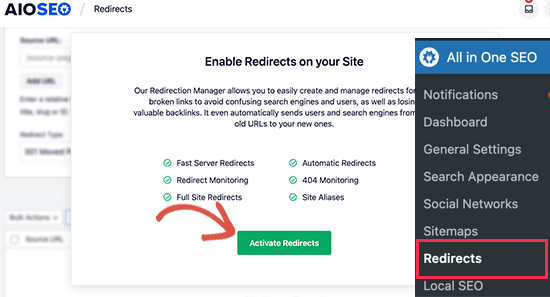
Ardından, ‘Tam Site Yönlendirmesi’ sekmesine geçmeniz ve ‘Sitenin Yerini Değiştir’ geçişini açmanız gerekir.
Bundan sonra, ‘Etki alanına taşı’ seçeneğinin yanına yeni etki alanı adınızı girmeniz gerekir.
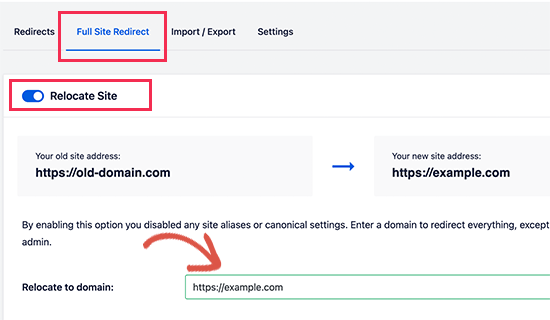
Ayarlarınızı kaydetmek için ‘Değişiklikleri Kaydet’ düğmesine tıklamayı unutmayın.
Yöntem 2: Yeni Etki Alanına Yönlendirmeleri Elle Ayarlama
Bu yöntem, eski alan adınızdaki WordPress .htaccess dosyasını düzenlemenizi gerektirir.
Öncelikle, FTP kullanarak eski sitenize bağlanmanız ve .htaccess dosyasını düzenlemeniz gerekir.
Bu, wp-includes veya wp-admin klasörünüzle aynı dizinde bulunacaktır. .htaccess dosyasını açın ve aşağıdaki kod satırlarını en üste yapıştırın:
1 2 3 | #Options +FollowSymLinksRewriteEngine onUnchanged: RewriteRule ^(.*)$ http://www.newsite.com/$1 [R=301,L] |
Yukarıdaki kodda newsite.com yerine yeni alan adınızı yazdığınızdan emin olun.
Bu değişiklikleri uyguladıktan sonra eski alan adınızı ziyaret edin. Sizi otomatik olarak yeni alan adına yönlendirmesi gerekir.
Olmazsa, yönlendirme düzgün ayarlanmamış demektir ve sunucunuz büyük olasılıkla yönlendirme kurallarını desteklemiyordur. RewriteEngine’i etkinleştirmek için web barındırma şirketinizdeki destek ekibiyle iletişime geçmeniz gerekir.
Adım 5: Google’ı Yeni Alan Adınız Hakkında Bilgilendirin
Artık WordPress’i yeni bir alan adına taşıdığınıza ve yönlendirmeleri ayarladığınıza göre, adres değişikliğinizi Google’a bildirmenin zamanı geldi. Bu, Google’ın yeni web sitesi alan adınızı hızlı bir şekilde bulmasına ve arama sonuçlarında göstermeye başlamasına yardımcı olacaktır.
Öncelikle, hem yeni hem de eski alan adlarınızın Google Search Console’a iki farklı özellik olarak eklendiğinden emin olmanız gerekir. Talimatlar için Google Search Console kılavuzumuzdaki 1. adıma bakın.
Ardından, Google Search Console hesap kontrol panelinizde eski alan adını etkin mülk olarak seçmeniz gerekir.
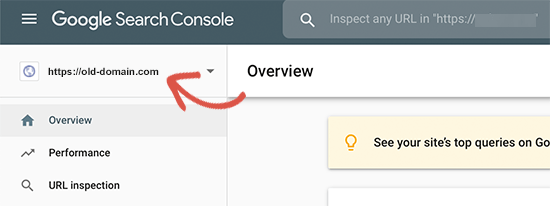
Bundan sonra, sol sütundan Ayarlar menüsüne tıklayın.
Şimdi, ‘Adres değişikliği’ aracına tıklayabilirsiniz.
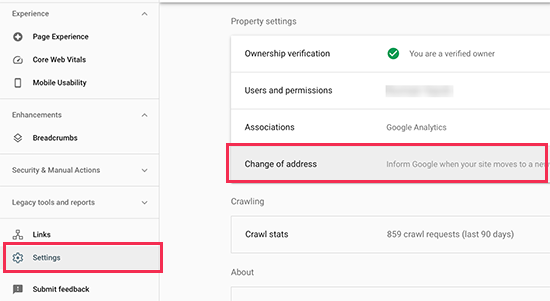
Şimdi, Google’ı Güncelle bölümünden yeni alan adınızı seçmeniz gerekiyor.
Ardından, ‘Doğrula ve Güncelle’ düğmesine tıklamalısınız.
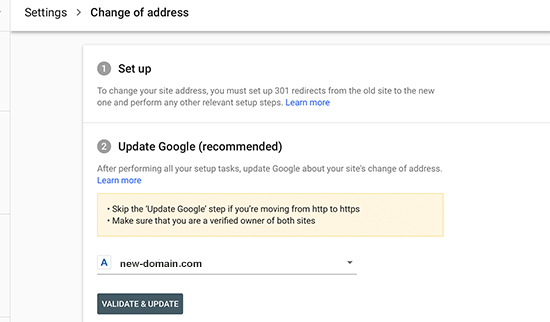
Hepsi bu kadar. Google şimdi eski alan adınızın yeni alan adına yönlendirildiğini doğrulayacak ve değişikliklerinizi kaydedecektir.
Bir sonraki ekranda, Google Search Console adres değişikliği talebinizi göndermeniz için size adım adım bir sihirbaz gösterecektir.
Kullanıcılarınızı Yeni Alan Adı Hakkında Bilgilendirme
301 yönlendirmeleri görevini yerine getirirken, geçiş hakkında kamuoyuna bir duyuru yapmak her zaman iyidir.
Bunu, yeni sitenizle ilgili bir blog yazısı yazarak ve bunu sosyal medya hesaplarınızda paylaşarak yapabilirsiniz.
E-posta bülteniniz veya anlık bildirim aboneleriniz varsa, onlara da bir duyuru göndermelisiniz.
Bu pek çok açıdan faydalı olabilir.
Her şeyden önce, kullanıcılarınızın yeni alan adını okuduktan sonra hatırlama olasılığı daha yüksektir.
İkinci olarak, kullanıcılarınızdan herhangi bir hata gördüklerinde size bildirmelerini isteyebilirsiniz. Sitenizi her tür tarayıcıda veya sistem ortamında tek başınıza test edemezsiniz, bu nedenle sitenize yeni bir çift gözün bakması her zaman yararlıdır.
Video Eğitimi
Bonus Kaynaklar
Aşağıdaki makaleler ve eğitimler, yeni bir alan adına geçtikten sonra SEO sıralamalarınızı takip etmenize ve yeniden kazanmanıza yardımcı olacaktır:
- Nihai WordPress SEO Geçişi Kontrol Listesi (Yeni Başlayanlar İçin)
- WordPress Blog Yazılarınızın Doğru Anahtar Kelimeler İçin Sıralanıp Sıralanmadığını Nasıl Kontrol Edebilirsiniz?
- WordPress Sitenize Gelen Web Sitesi Ziyaretçileri Nasıl Takip Edilir?
- Blog Yazılarınızı Bir Profesyonel Gibi SEO İçin Optimize Etmenin İpuçları (Kontrol Listesi)
Umarız bu eğitim WordPress sitenizi yeni bir alan adına taşımanıza yardımcı olmuştur. Ayrıca ücretsiz e-posta alan adı alma kılavuzumuzu görmek veya eksiksiz WordPress SEO kılavuzumuzdaki adımları takip etmek isteyebilirsiniz.
If you liked this article, then please subscribe to our YouTube Channel for WordPress video tutorials. You can also find us on Twitter and Facebook.





WPBeginner Staff
We are not sure about this option, we haven’t tried it ourselves so we can not recommend it. Any redirection you set up needs to be 301 so that search engines can update the new location.
vikramforever
I have my domain with godaddy and they have redirect option with match path mentioned on their help page – http://support.godaddy.com/help/article/5120/redirect-urls-with-your-hosting-account.
Is this a feasible option when i transfer my active site to another domain? As per the option in the post, i need to maintain the hosting for my old domain till the time i want the redirects to work. Using redirect with the ‘match path’ option will do away the need to do so. But i want to be sure that this is an option which works the same way the script (as you mentioned) works.
Keely Worth
Excellent – makes the process of moving a WordPress site a breeze. Thanks.
Ayman
I’ve just migrate a website site from one URL to another. I would really like to thank you for this great post. 100% working and a very simple instructions
Anas Khan
Nice post. I have few questions too,
I have 2 blog on WordPress. The new blog is active and i have 45 posts in my new blog. The old blog has 192 posts and all posts are index on google.
Now i want to transfer and publish all old 192 posts to my new blog so all posts can me view on my new blog. If i trash all posts from my old blog, remove the sitemap and webmaster tool of old blog and after 30 days i publish old posts to new blog using Add new post button then it works ? Is it considered a duplicate content ?
WPBeginner Support
You can simply import those posts to your new blog and set up a 301 redirection on your old posts on a post by post basis.
Admin
Mohammed Saimon
Yes its a nice post. Thanks to the author.
Vinish Garg
This is an excellent post and gave me some new direction for moving my WP blog from one domain to another. I will appreciate if you can correct me if I am wrong in planning it as below.
– I know hostgator and I understand how to use File Manager and setup WP, database and import/export database (xml files)
– My current WP blog is at: http;//www.example.com, and I want to move it to another domain http://www.example.org.
– One, I will setup new WP at new domain’s root (database, config file, custom theme, and import data file from old site)
– The new site will show the site exactly like old site, BUT only difference is the URL (because of new domain).
If everything is correct this far… I am not sure how to use redirects for all my old domain’s pages/posts to new domain. Can you please advise?
WPBeginner Support
You can do that by following the step 3 of this guide, setting up 301 redirects.
Admin
Stefan
Great post, unfortunately I have read it too late and have already moved my domain. All I have done is I have purchased a new domain for my blog (, before it was it’s still active for another 2 months). I have changed the WordPress URL and Site Address in wordpress general settings and resubmitted the sitemap with the new URL. That’s all I have done.
This was one month ago and since then the traffic is now totally down, from more than 1,000 pageviews a day to now not even 200.
If I google search “thailand redcat” not even one of my pages shows up. The sitemap however has successfully been submitted:
2:51:35pmStefan
Do you know what could be the reason for this and how can I solve the problem and get the search results and eventually traffic back to normal again?
Any help would greatly be appreciated. Cheers!
WPBeginner Support
Stefan, we are not sure we understand the process you followed to move your site to a new domain. Here are some general tips. First make sure search bots are able to crawl and index your site? Check your site in Google webmaster tools for crawl errors.
Admin
Charlie
I have the same problem. Google crawlers find a 500 error on the whole site since is did the migration. I tried on 2 different environments/providers, different php versions, I tried to deactivate/reactivate all my plugins one by one, I tried to regenerate the permalinks, the htaccess, the robots.txt… nothing works.
Mr Joy
Thank you for your great post. I followed your post and moved my site to new domain. It’s all working fine but there is only one problem in my site regarding WordPress visual editor. The problem is “When I upload an Image on any post by Add Media option, then click on the picture thumble “edit image” an iFrame come with a Not Found Error. But when click delete it works fine. Please help me to resolve the problem. Check the screenshot : http://bit.ly/1fqjE1b
WPBeginner Support
The first thing you can try is to update your permalinks, simply go to Settings » Permalinks and click on the save changes button.
Admin
AP
Excellent work – thanks very much! It might be helpful to add the reply above – the one dealing with new database creation and use – to the initial instructions, as not everyone will read the comments before attempting a transfer.
Gary Kirwan
Great article. My question is I use the affiliate cloaking method recommended by Yoast, which means I have a .htaccess file under a folder called /out/
Would I need to add the same 301 redirect code mentioned in the article to both .htaccess files in the root directory and affiliate links sub-folder? Does adding the 301 redirect code to the root directory .htaccess file only automatically cover the sub-folders one?
My goal is to make sure that external affiliate links work correctly as well.
Kingsley
Great tutorial, will be using it to Migrate http://www.ideacrunch.org to http://technblogging.com in the next few days but i have a question to ask. The database password and username name will it be the same as the old site?
Craig
Hi, appreciate this is a little late. But i literally just want to move from http://www.unlockworldtv.co.uk to http://www.unlockworldtv.com is this tutorial suitable for that? I am not moving hosts, just changing the url
WPBeginner Support
Yes it is.
Admin
Craig
Thanks. I’m stuck at the go to newsite.com/installer.php I just get my old site but with 404. I didn’t install wp in the new directory, just created an empty directory to put the installer and zip in. I am pointing my new domain from the registrar account to that new directory with my web host but not getting anything but the theme and 404. Any obvious tips?
Craig
just FYI i resolved this. It appears to be an issue with 1&1 (no surprise) but can be resolved by having an index.html file present. So for anyone on 1&1 adjust step 2 from
“Make sure that the root directory, or the directory where you want to copy your website is completely empty.” to “Make sure that the root directory, or the directory where you want to copy your website is completely empty except for installer.php, the .zip file AND an index.html page”
I believe this is to do with the way 1&1 prioritise pages on their server.
Denis Fitzgerald
Hi – Thanks for the article. I have a question: I am switching my site from Tumblr to WordPress. It has its own domain. I would like to know if the buttons at the end of each article showing social shares, Twitter, Facebook, Google+, will maintain the original share count or go back to zero. Thank you.
WPBeginner Support
If its the same domain and your URL structure remains intact, then hopefully you will be able to retain those social counts.
Admin
Bertjan
Excellent guide! Thank you very much.
Sudha Mathew
Hi, I moved my site using redirects about 6 months ago and it works fine. I need to renew my contract with web security company soon. So I need to know how much traffic is still getting redirected from the old site. Could you explain how to do that? I am not tech savvy but can use both Webmaster tools and Google Analytics.Thanks in advance!
Best
Sudha
Moti
Hello,
I would like to change the domain name of my site (staying on the same host).
In the instructions above it is indicated that I should “make sure that the root directory, or the directory where you want to copy your website is completely empty.”.
In my case the WP is installed in the root directory (I have the wp-content folder under public-html) – I assume that this means that my WP is installed under the root directory.
Which folders should I clean / delete before I run the installed file generated by the duplicator ?
Thanks,
Moti.
Declan
Thank you for the tutorial. Worked great with no problems whatsoever.
I do, of course, have a question regarding SEO.
My old site wasn’t registered in Google webmaster tools, so obviously there’s no option to let them know about the changes I’ve made. My question is: Will I need to register my old domain with Google webmaster tools first, and then my second domain…and then notify them abut the changes?
Any thoughts would be great.
Thanks again for the article, it was extremely helpful.
Declan.
WPBeginner Support
Yes, you will have to notify about the change on your old site’s webmaster tools account. However, this is just the fastest way to do it. If you have setup your 302 redirects then search engines would pick that up as well.
Admin
reza
hi,
this works just great, i redirect my old.com which is my main domain to new.com which is an addon domain (in the same hosting)
but when i added another new addon domain, it makes my new addon domain can’t be accessed….it always redirect my addon.com to new.com/addon.com…
can you help ??
Jennifer @ Delicieux
Thank you for explaining this in so much detail. I have a question though. I’ve been thinking about moving to a new domain name for some time, but I wanted to know if I would have any issues given the fact that earlier in the year I changed the permalink structure on my old blog.
I followed the instructions on Yoast on how to change my permalink structure and edited my .htaccess file, and wonder if this will cause problems when I move to a new domain? This is the one thing that is holding me back because I don’t want things to screw up and lose rank and end up with broken links.
WPBeginner Support
you can transfer your old .htaccess file to your new site. If the .htaccess file has any references to the old domain name then replace those with the new domain name and your would be OK.
Admin
Hrayr
Hey,
First of all many thanks for this article – it worked great without any problem for me!
I have one simple question specific to my case, would highly appreciate your thoughts on this.
Basically i used this approach to copy my wordpress site from localhost to the host/domain from 3rd party.
As said all worked ok – i just want to make sure that this approach doesn’t leave any old urls/links/references that can “annoy” google to crawl this new site. My site is pretty basic, so in worst case scenario i can just recreate if there is any disadvantage of crawling/SEO when site is copied by duplicator.
Is there any known SEO issue of new site that you are aware of?
WPBeginner Support
We not aware of any SEO issues, but if you come across any you can inform the plugin author by opening a support thread on plugin’s page.
Admin
Kevin
I don’t think the way you suggest users do their 301 redirect is the best way. It’s well documented, even recommended by Google, that you do page-to-page redirects, NOT dump all your old website’s pages to the homepage of the new site. The htaccess code you provide does the latter. It isn’t a good way to preserve link juice.
Maybe you can refer us to a good htaccess tutorial instead? There are also online htaccess generators out there that can make it much faster to do page-to-page redirects.
WPBeginner Support
Kevin, you are right and rewrite rules in the article do exactly that. Instead of redirecting users to the homepage it sends them to the individual page. $1 at the end of code appends the link with the proper permalink structure.
Admin
Julian
Hi, when I’m doing this after ‘deploy’ it misses the ‘update’ section and reverts back to a 404 page at the old web address… any idea what could be causing this?
Many thanks!
Munna
Thank you very much for this post. I was in trouble redirecting my oldsite visitors to the new site. But your .htaccess code made it super easy because both sites were in the same hosting server.
Raspal
Hello,
I completed all the steps and the blog at the new site is up fine. But I can’t login to the admin area. I have two users, one is an admin user. I get this error when trying to login:
“ERROR: Cookies are blocked or not supported by your browser. You must enable cookies to use WordPress.”
I tried different browsers and also tried clearing any cookies. Also tried changing password. Password was changed fine but still getting the above error.
Can you please help ASAP?
Using WP version 3.7.1
Regards,
Raspal
Neil Bargas
Thanks man! 100% working and a very simple instructions.
Lynn
Fantastic article! You are my hero of the day.
Jahid
”Login to your new site’s WordPress admin using the same username and password that you had on the old site. Go to Settings » Permalinks in your new site’s WordPress admin and click on the save button.”
Once I login, it shows me the first step page ”Step 1: Files & Database” instead of showing the WP dashboard. Help!
WPBeginner Support
Seems like you need to update your wp-config.php file
Admin
Chrissy
Hi! Thanks so much for this helpful article – I’m in the process of running through the steps now.
My one question is:
I have my blog hosted at one domain, let’s call it http://www.reallylongdomainname.com/blog, but I have a redirect to forward it to my other domain: blog.shortername.com. I now want to migrate the blog to shortername.com/blog, because some of the links don’t work after the redirect.
All my posts and things already have permalinks at shortname.com/blog/post#, so do I really need to do any of this 301 stuff? Am I safe to skip steps 3, 4 & 5, or is there something I need to consider? And will I need to delete the old blog or just the redirect once I launch it at the new domain?
Would be really great to find out how to proceed, since I’ve tried dozens of things this week and no situation is quite the same as mine :/ Thanks!
WPBeginner Support
The purpose of 301 redirects is to not just redirect users but also let search engines know that you have moved to the new location so step 3 and 4 are a must otherwise it may affect your SEO rankings.
Admin
Mark P
Great post. One question though.
Let’s say someone clicks on a backlink for my website’s old domain. (Let’s call it olddomain dot com / blogpost1). Will this then redirect to the new domain’s respective link (newdomain dot com / blogpost1) instead of just redirecting to the new domain’s homepage?
WPBeginner Support
Yes, it would redirect users landing on your posts and pages on the old site to the posts/pages on the new site.
Admin
Mark P
Thank you!
Morgan
Question: I am switching my site from one host to a new host. At the same time, I am changing my domain name. I have already successfully transferred my WordPress site to my new host using the new domain name. I now am to step 3 and want to use 301 redirects to point those old URLs to the new site URLs. However, the old site is on the old host and I’m planning on getting rid of that site.
Will the 301 redirects still work? Or do I also need to move the old site over to my new host and THEN do the redirects? I’m a bit unsure what to do and would love any advice.
WPBeginner Support
If it is possible for you to keep the old site online for at least a month, then you can add 301 redirect. After that update your site’s information on Google Webmaster tools. Once you have recovered your search rankings and traffic you can then close your account with the old web host.
Admin
Nj
Thank you for the helpful posts, but sometimes with such plugins, a video will help A LOT. I hope you will consider this
Thanks again
Arnold
Hi. Could you please elaborate the part where you said “The installer will ask you to provide database information for the new site and check the box for Table removal?” Where do I find this database information? So should I check the box for Table removal? Thanks!
WPBeginner Support
This is the database where you will be importing your old site from the package you created earlier. Log into your web hosting dashboard, find phpmyadmin and create a new database. Come back to installer.php and provide the new database name, host, user and password.
Admin
Kara Lumsden
So you should not install wordpress on the root of the new domain? The only thing you need to do on the new domain is only create a new database, is that correct? Can you elaborate a little more on how to create the database in phpmyadmin?
So appreciative, thank you for all that you do!
WPBeginner Support
No it is OK to install WordPress on the root of the new domain. Yes, you just need to create a new database and the Duplicator takes care of the rest.
Kara Lumsden
Can you please provide instructions on how to create the database?
Thank you very much,
Kara
Dennis J. Smith
How long should one wait before deleting the old site?
WPBeginner Support
30 to 90 days, depends on how successful your move was. If you are confident that your new domain has gained nearly the same traffic as the old site, then you can delete it.
Admin
dyer
Hi ive encountered an issue. Im unable to save my Permalinks as I cant locate the WP admin file ive tried to upload the WP admin file again but this hasn’t the issue please could you advise me if there is any other steps I can take to rectify this issue.
Thanks
Dyer
WPBeginner Support
@dyer We are unable to understand your question. We are assuming that you can not access your WordPress Admin area. In that case, connect to your site using an FTP client like filezilla. Find the file
.htaccessdownload it to your hard disk and delete it from your website. Hope this resolves your issue.Admin
Fakhre
Thanks for the article guys!
I am hosting my site on Bluehost and just want to change the Domain name without loosing the SEO and backlinks.
My site contents is huge, i have about 8000 posts. Any solution for renaming the domain??
Sanjay Patel
Hello…
Really useful information but duplicator plugin is not working in my website. please solve my problem. how to do this?
Thanks in advance.
Dinah
Does this work with moving from one domain to a subdomain?
Editorial Staff
Yes
Admin
Dinah
Does this work for moving to a new subdomain? Like if my wordpress blog was on oldsite.com and I wanted it on blog.newsite.com, would I do the same thing?
Editorial Staff
Yes.
Admin
Emmie
I recently did this and the links and all redirected fine and dandy, however I just got slapped by Google with a penalty for instantly having so many backlinks – they think I bought them. Has anyone else encountered this? I made the appropriate notifications in Google Webmaster tools before moving, and it’s done nothing to help this. It’s hit me hard, so if anyone has experience in remedying this, please share!
Editorial Staff
Hey Emmie, where do you see that you get slapped for having too many backlinks? Does it show you that error in your Webmaster Tools? Just trying to see how did you come to the conclusion that you got penalized by google.
https://www.google.com/webmasters/tools/reconsideration << This is the page where you can send a reconsideration request to Google.
Admin
Lateef Adewale
Do you have any idea if this will work if i am moving a site from Bluehost to Wp Engine.
Editorial Staff
Yes it should work.
Admin
Emily
Just went through this whole process, worked perfectly and just what I needed to know. Thank you WPBeginner! The only glitch I ran into was my own fault – didn’t deactivate my security plugins first so I had to do it all over. Now, I am an expert… : )
Sandra Christie
Thanks for the article!
Are the steps for moving the same domain to a new host basically the same? And can that cause a drop in SEO as well?
Travis Pflanz
As well, the “Change of Address” option in Webmaster Tools is now in the Options menu at the top right in in Gear icon.
Zach Smith
Thanks for publishing another great article for us. This is best for any technology related blog.
Bob
Thanks–this is great information. I’m really excited to learn about Duplicator. While moving a domain is something I might have to do occasionally, I’m constantly cloning environments for development and testing purposes. The manual cloning process I’ve been using is time-consuming and potentially error-prone. Duplicator has the potentially to be a considerable improvement!
Sam
I just moved WP to a new domain and server using this method. Webmaster Tools now shows many 403 errors on the new server for each folder in uploads such as wp-content/uploads/2012/07 and one 403 error for each of the months. On my old server I did not get this. When moving the site should we also change or check the permissions? What should they be for the wp-content/uploads folder?
Editorial Staff
Google should not be indexing the folders rather they should be indexing the files inside of it. If you try to access the folder directly using a browser, WordPress will give you a 404 error. You don’t want to allow access to a directory that has no index page, which will then produce a directory listing that will get indexed and crawled, including the links to all files.
Admin
sam
Thanks for the reply. Then why does Google show a 403 error for the folders in webmaster tools. Does this not mean that something is wrong?
Zimbrul
THIS IS THE ARTICLE I WAS LOOKING FOR 1 YEAR NOW!!
Editorial Staff
Better late than never
Admin
Jasim Ahmed
Duplicator is great plugin but problem is its not work with some server as its need higher PHP version except this is there any other way to do ?
Editorial Staff
Yes, you can manually download the files and the database. Upload them on the new domain. Replace all the old url instances in the database using phpMyAdmin SQL search and replace query. The easier solution would be to ask your host why they are not on the higher versions of PHP or switch to a better host.
Admin
iAn
hi, I believe this won’t preserve your social network network sharing counters (number of shares and likes). Any idea how to retain those popularity meter?
Editorial Staff
You can’t retain the social counts because those go based on your canonical URLs which will be the new site (very important for SEO). The counters are mainly for social proof. All existing links in social media will properly redirect, so you won’t lose any traffic there.
Admin